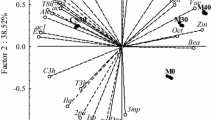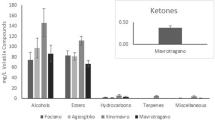Abstract
Sweet Sherry wines from Pedro Ximénez and Muscat sun and chamber-dried grapes during vintages 2009 and 2010 were aged in American oak wood for 12 months. Their volatile content was periodically analyzed using SBSE-GC-MS. Cluster analysis and principal component analysis demonstrated that the volatile compounds considered can be used to detect grape variety and vintage. Principal component analysis for each grape variety, clearly differentiated aging time and vintage. Drying type was the least significant factor. Sweet wines produced using chamber driers were from Pedro Ximénez and Muscat grapes provides similar in volatile constituents as those produced by traditional process.



Similar content being viewed by others
References
Alves RF, Nascimento AMD, Nogueira JMF (2005) Characterization of the aroma profile of Madeira wine by sorptive extraction techniques. Anal Chim Acta 546:11–21
Bordiga M, Piana G, Coïsson JD, Travaglia F, Arlorio M (2014) Headspace solid-phase micro extraction coupled to comprehensive two-dimensional with time-of-flight mass spectrometry applied to the evaluation of nebbiolo-based wine volatile aroma during ageing. Int J Food Sci Technol 49:787–796
Cámara JS, Alves MA, Marques JC (2006) Changes in volatile composition of Madeira wines during their oxidative ageing. Anal Chim Acta 563:188–197
Casas J (1985) Descripción resumida de la técnica enológica de los vinos de Jerez. In: University Of Cadiz Press (ed) III jornadas universitarias sobre el Jerez. A. Jiménez-Mena, Cadiz, pp. 333–361
Chatonnet P (1999) Discrimination and control of toasting intensity and quality of oak wood barrels. Am J Enol Vitic 50:479–494
Chaves M, Zea L, Moyano L, Medina M (2007) Changes in color and odorant compounds during oxidative aging of Pedro Ximenez sweet wines. J Agric Food Chem 55:3592–3598
Dennis EG, Keyzers RA, Kalua CM, Maffei SM, Nicholson EL (2012) Grape contribution to wine aroma: production of hexyl acetate, octyl acetate, and benzyl acetate during yeast fermentation is dependent upon precursors in the must. J Agric Food Chem 60:2638–2646
Fenoll J, Manso A, Hellín P, Ruiz L, Flores P (2009) Changes in the aromatic composition of the Vitis vinifera grape Muscat Hamburg during ripening. Food Chem 114:420–428
Franco M, Peinado RA, Medina M, Moreno J (2004) Off-vine grape drying effect on volatile compounds and aromatic series in must from Pedro Ximénez grape variety. J Agric Food Chem 52:3905–3910
García-Jares C, García-Martín S (1995) Analysis of some highly volatile compounds of wine by means of purge and cold trapping injector capillary gas chromatography. Application to the differentiation of Rias Baixas Spanish white wines. J Agric Food Chem 43:764–768
Hernández-Orte P, Cacho JF, Ferreira V (2002) Relationship between varietal amino acid profile of grapes and wine aromatic composition. Experiments with model solutions and chemometric study. J Agric Food Chem 50:2891–2899
Hernández-Orte P, Ibarz M, Cacho J, Ferreira V (2005) Effect of the addition of ammonium and amino acids to musts of airen variety on aromatic composition and sensory properties of the obtained wine. Food Chem 89:163–174
Karagiannis S, Economou A, Lanaridis P (2000) Phenolic and volatile composition of wines made from Vitis vinifera cv. Muscat Lefko Grapes from the Island of Samos. J Agric Food Chem 48:5369–5375
Lee S, Rathbone D, Asimont S, Roland A, Ebeler SE (2004) Dynamic changes in ester formation during chardonnay juice fermentations with different yeast inoculation and initial brix conditions. Am J Enol Vitic 55:346–354
López de Lerma N, García-Martínez T, Moreno J, Mauricio JC, Peinado RA (2012) Volatile composition of partially fermented wines elaborated from sun dried Pedro Ximénez grapes. Food Chem 135:2445–2452
Loscos N, Hernández-Orte P, Cacho J, Ferreira V (2010) Evolution of the aroma composition of wines supplemented with grape flavour precursors from different varietals during accelerated wine ageing. Food Chem 120:205–216
Marais J, Van WyK CJ (1986) Effect of grape maturity and juice treatments on terpene concentrations and wine quality of Vitis vinifera L. cv. weisser Riesling and Bukettraube. S Afric J Enol Vitic 7:26–35
Márquez R, Castro R, Natera R, García-Barroso C (2008) Characterisation of the volatile fraction of andalusian sweet wines. Eur Food Res Technol 226:1479–1484
Ministerio de Agricultura, Alimentación y Medioambiente (2015) Agencia Estatal de Meteorología website (Spanish Goverment). http://www.aemet.es. Accessed 17/05/15
Ortega-Heras M, González-Huerta C, Herrera P, González-Sanjosé ML (2004) Changes in wine volatile compounds of varietal wines during ageing in wood barrels. Anal Chim Acta 513:341–350
Ortega-Heras M, Pérez-Magariño S, Del-Villar-Garrachón V, González-Huerta C, Moro LC, Guadarrama A, Villanueva S, Gallo R, Martín de la Helguera S (2014) Study of the effect of vintage, maturity degree, and irrigation on the amino acid and biogenic amine content of a white wine from the verdejo variety. J Sci Food Agric 94:2073–2082
Ramey D, Ough C (1980) Volatile ester hydrolysis or formation during storage of model solutions and wines. J Agric Food Chem 25:928–934
Rapp A (1998) Volatile flavour of wine correlation between instrumental analysis and sensory perception. Nahrung 42:351–363
Rapp A, Mandery H (1986) Wine aroma. Experientia 42:873–884
Ruíz Bejarano MJ, Rodríguez Dodero MC, Barroso CG (2010) Optimizing the process of making sweet wines to minimize the content of ochratoxin A. J Agric Food Chem 58:13006–13012
Ruiz MJ, Zea L, Moyano L, Medina M (2009) Aroma active compounds during the drying of grapes cv. Pedro Ximenez destined to the production of sweet Sherry wine. Eur Food Res Technol 230:429–435
Ruiz MJ, Moyano L, Zea L (2014) Changes in aroma profile of musts from grapes cv. Pedro Ximenez Chamber-dried at controlled conditions destined to the production of Sweet Sherry Wine. LWT - Food Sci Technol 59:560–565
Ruiz-Bejarano MJ, Castro-Mejías R, Rodríguez-Dodero MC, García-Barroso C (2013) Study of the content in volatile compounds during the aging of sweet Sherry wines obtained from grapes cv. Muscat and fermented under different conditions. Eur Food Res Technol 237:905–922
Sánchez-Palomo E, Díaz-Maroto MC, Pérez-Coello MS (2005) Rapid determination of volatile compounds in grapes by HS-SPME coupled with GC-MS. Talanta 66:1152–1157
Schreier P (1979) Flavor composition of wines: a review. Crit Rev Food Sci Nutr 12:59–111
Serratosa MP, Márquez A, Moyano L, Zea L, Mérida J (2014) Chemical and morphological characterization of chardonnay and Gewürztraminer grapes and changes during chamber-drying under controlled conditions. Food Chem 159:128–136
Silva AC, Hogg T, Guedes de Pinho P (2003) Identification of key odorants related to the typical aroma of oxidation-spoiled white wines. J Agric Food Chem 51:1377–1381
Valero A, Marín S, Ramos AJ, Sanchis V (2008) Survey: ochratoxin A in European special wines. Food Chem 108:593–599
Vega-Mercado H, Marcela Góngora-Nieto M, Barbosa-Cánovas GV (2001) Advances in dehydration of foods. J Food Eng 49:271–289
Versini G, Carlin S, Dalla A, Nicolini G, Rapp A (2002) Formation of 1,1,6 trimethyl-1,2-dihydronaphthalene and other norisoprenoids in wine: considerations of the kinetics. In: Winterhalter P, Rouseff R (eds) Carotenoid-derived aroma compounds, ACS symposium series 802. American Chemical Society, Washington DC, pp. 285–299
Author information
Authors and Affiliations
Corresponding author
Rights and permissions
About this article
Cite this article
Ruiz-Bejarano, M.J., Castro-Mejías, R., del Carmen Rodríguez-Dodero, M. et al. Volatile composition of Pedro Ximénez and Muscat sweet Sherry wines from sun and chamber dried grapes: a feasible alternative to the traditional sun-drying. J Food Sci Technol 53, 2519–2531 (2016). https://doi.org/10.1007/s13197-016-2192-1
Revised:
Accepted:
Published:
Issue Date:
DOI: https://doi.org/10.1007/s13197-016-2192-1




